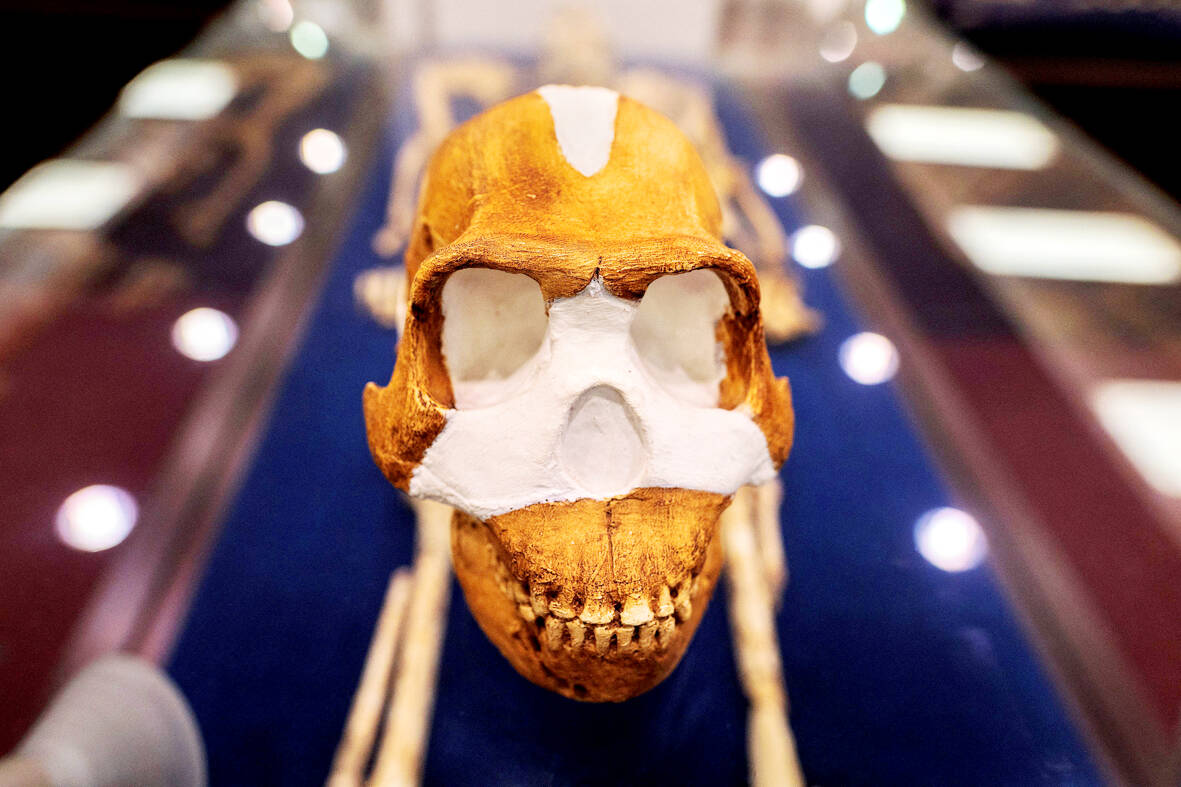An ancient human cousin may have buried its dead and carved symbols into cave walls, surprising findings for a creature with a small brain.
Fossil remains of the species — named Homo naledi — were uncovered in underground caves in South Africa a decade ago. Now, researchers say they’ve found evidence that the species was capable of complex behavior that so far has only been seen in those with bigger brains.
“We are facing a remarkable discovery here” for a species with brains one-third the size of humans, said anthropologist Lee Berger, who led the research funded by the National Geographic Society, where he now works.

Photo: AFP
Berger and colleagues describe their findings in studies posted online Monday. The research has not been peer-reviewed yet and some outside scientists think more evidence is needed to challenge what we know about how humans evolved their complex thinking.
“There’s still a lot to uncover,” said Rick Potts, director of the Smithsonian’s Human Origins Program who was not involved in the research.
H. naledi is a pretty new addition to the family tree of hominins, which includes our direct ancestors and other extinct relatives who walked on two legs. Berger and his team announced the species in 2015, after a tip from local spelunkers led them to the Rising Star cave system near Johannesburg where they uncovered fossils from at least 15 individuals who lived around 300,000 years ago.
These creatures had some traits in common with modern humans, like legs made for walking upright and hands that could work with objects, said University of Wisconsin-Madison anthropologist John Hawks, a member of the research team. But other features looked more ancient, including their small brains.
In recent years, team members have ventured back into the caves, a tricky descent through tight underground spaces. What’s down there shows the species in a new light, they reported.
One of the new studies describes what researchers say were intentional burial sites. The team uncovered fossil remains of adults and children in shallow holes in the ground, their bodies in a fetal position.
Another study describes a series of marks carved into the cave walls, including geometric patterns and cross-hatched lines.
“This is something that takes a lot of time and effort to do,” said Berger, who led the initial research while at the University of the Witwatersrand in Johannesburg.
All of this behavior would be surprising for a creature whose brain was closer in size to an ape’s than a human’s, experts said.
Decades ago, we thought Homo sapiens were the only ones who could figure out how to use fire, bury their dead or create art, said Chris Stringer, a human evolution expert at London’s Natural History Museum who was not involved in the research.
Since then, we’ve learned that other groups like Neanderthals also lived complex lives. But those species still had big brains — unlike H. naledi, whose burials would raise further questions about human evolution, Stringer said.
Scientists haven’t yet been able to identify how old the engravings are. So Potts said the current evidence can’t say for sure whether H. naledi was truly the one to create the symbols, or if some other creature — maybe even H. sapiens — made its way down there at some point.
For study author Agustin Fuentes, an anthropologist at Princeton University, the H. naledi evidence takes the focus off brain size.
“Big brains are still important,” Fuentes said. “They just don’t explain what we thought they explained.”

On April 26, The Lancet published a letter from two doctors at Taichung-based China Medical University Hospital (CMUH) warning that “Taiwan’s Health Care System is on the Brink of Collapse.” The authors said that “Years of policy inaction and mismanagement of resources have led to the National Health Insurance system operating under unsustainable conditions.” The pushback was immediate. Errors in the paper were quickly identified and publicized, to discredit the authors (the hospital apologized). CNA reported that CMUH said the letter described Taiwan in 2021 as having 62 nurses per 10,000 people, when the correct number was 78 nurses per 10,000

As Donald Trump’s executive order in March led to the shuttering of Voice of America (VOA) — the global broadcaster whose roots date back to the fight against Nazi propaganda — he quickly attracted support from figures not used to aligning themselves with any US administration. Trump had ordered the US Agency for Global Media, the federal agency that funds VOA and other groups promoting independent journalism overseas, to be “eliminated to the maximum extent consistent with applicable law.” The decision suddenly halted programming in 49 languages to more than 425 million people. In Moscow, Margarita Simonyan, the hardline editor-in-chief of the

Six weeks before I embarked on a research mission in Kyoto, I was sitting alone at a bar counter in Melbourne. Next to me, a woman was bragging loudly to a friend: She, too, was heading to Kyoto, I quickly discerned. Except her trip was in four months. And she’d just pulled an all-nighter booking restaurant reservations. As I snooped on the conversation, I broke out in a sweat, panicking because I’d yet to secure a single table. Then I remembered: Eating well in Japan is absolutely not something to lose sleep over. It’s true that the best-known institutions book up faster

Though the total area of Penghu isn’t that large, exploring all of it — including its numerous outlying islands — could easily take a couple of weeks. The most remote township accessible by road from Magong City (馬公市) is Siyu (西嶼鄉), and this place alone deserves at least two days to fully appreciate. Whether it’s beaches, architecture, museums, snacks, sunrises or sunsets that attract you, Siyu has something for everyone. Though only 5km from Magong by sea, no ferry service currently exists and it must be reached by a long circuitous route around the main island of Penghu, with the